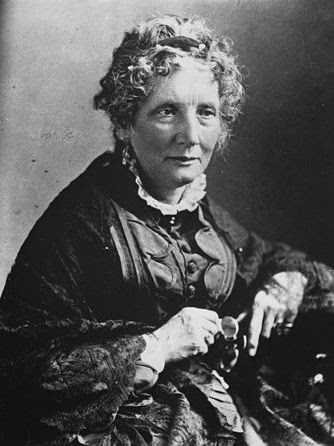 |
| Harriet Beecher Stowe ca. 1870s/1880s |
Harriet Elizabeth Beecher was born in Litchfield, Connecticut, in June 1811 into the already numerous family of the Congregationalist preacher Lyman Beecher. She was the sixth of altogether eleven surviving children. Her mother Roxana Foote Beecher died when she was a little girl and therefore Harriet became particularly attached to her oldest sister Catharine who had a strong influence on her views regarding the life of women and other social issues. Later she was at very good terms with her stepmother Harriet Porter Beecher as well.
Being the daughter of an evangelical Calvinist with strict religious principles and a strong sense of justice, Harriet Beecher was brought up to contribute to making the world a better place. At home the children were all encouraged to develop their debating talents, but they were sent to school, too. At Sarah Pierce's academy Harriet studied the classics, languages and mathematics instead of only ornamental arts like in almost all other girls’ schools of the time. When her sister Catharine founded the Hartford Female Seminary in 1823, Harriet completed her formal education there.
For a few years Harriet Beecher worked as a teacher at Catherine’s seminary, but in 1832 she moved to Cincinnati, Ohio (just across the river of the slave state Kentucky), with the family because her father became head of Lane Theological Seminary. The same year Catharine opened the Western Female Institute, another school for girls, where Harriet taught. The sisters became members of a literary salon called Semi-Colon Club that brought together not only literature lovers, but also critics of slavery. There Harriet befriended with Eliza and her husband Calvin Ellis Stowe.
Harriet Beecher had been writing ever since the age of seven, but began to give it a professional bent only in Cincinnati. In 1833 she and Catharine published a co-written textbook titled Primary Geography for Children that was received with praise from the local bishop. The following year Harriet turned to writing short stories for the Western Monthly Magazine of which her sister Catharine didn’t approve. Following the award of a prize for her story A New England Sketch, Harriet Beecher brought out a collection of more New England Sketches in 1835.
After the death of her friend Eliza, Harriet Beecher and Calvin Stowe got closer. In January 1836 they married and had seven children over the following sixteen years. They had a bare living with the salary that her husband received as a professor of biblical theology at Lane Theological Seminary which was a good reason for Harriet Beecher Stowe to continue writing short stories and articles for magazines. In her writing she could not only spread her thoughts and beliefs, but she could also contribute financially to the family income. Her husband encouraged her literary career.
In 1850 Calvin Stowe became a professor at Bowdoin College and the family moved to Brunswick, Maine. There Harriet Beecher Stowe finally set out to write her most famous novel, Uncle Tom’s Cabin, which is largely based on the life of Josiah Henson. The story was first published in instalments in The National Era between June 1851 and April 1852. The two-volume book became a best-seller right away in 1852. The following year the writer brought out A Key to Uncle Tom’s Cabin documenting the facts of her novel.
The family moved to Andover, Massachusetts, in 1853 where Calvin Stowe taught at the Theological Seminary until his retirement in 1864. Then they settled in Hartford, Connecticut, passing winters in Mandarin, Florida. Harriet Beecher Stowe continued to write stories, essays, textbooks and novels. In 1856 she produced another slave novel, Dred: A Tale of the Great Dismal Swamp, which was very successful. Notable novels of a different kind that she published are e.g. The Minister's Wooing (1859), Lady Byron Vindicated (1871), Palmetto Leaves (1873) and Poganuc People (1878).
Harriet Beecher Stowe died in Hartford, Connecticut, in July 1896 at the age of 85. She was buried at Phillips Academy in Andover, Massachusetts. The epitaph on her tomb stone reads:
For further information on the writer I suggest to visit the website of the Harriet Beecher Stowe Center at http://www.harrietbeecherstowecenter.org“Her Children Rise up and Call Her Blessed.”
or to read a biography like e.g.:
I love your blog. You write so much about my favourite authors and books. I read and reviewed Uncle Tom's Cabin a while ago. Maybe we can talk about it one day.
ReplyDeleteMarianne from Let's Read
Hello Marianne! Thanks for the feedback. As I said in another reply to a comment yesterday, it's always nice to find that my writings here is appreciated... and it's encouraging, of course.
DeleteAs for Uncle Tom's Cabin, I must admit that I never got round to reading it yet - which was an additional reason for portraying the author instead of reviewing her novel. There are some authors (especially such living in the nineteenth century) who I find more interesting for their character and life than for their literary achievements.